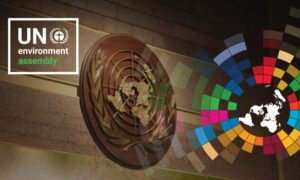Event Virtual
High-Level Briefing on the 6th Session of the United Nations Environment Assembly

06 Feb 2024
11:00–12:30
Venue: Online | Webex
Organization: Geneva Environment Network, UNEP Europe Office
This high-level briefing provided an update on the preparations and the presidency priorities for the sixth session of the UN Environment Assembly (UNEA-6), which will take place from 26 February to 1 March 2024, in Nairobi.
About this Event
This high-level briefing provided an update on the preparations and the presidency priorities for the sixth session of the UN Environment Assembly (UNEA-6), which will take place from 26 February to 1 March 2024, in Nairobi.
The United Nations Environment Assembly is the world’s highest-level decision-making body on the environment. This session’s theme “Effective, inclusive and sustainable multilateral actions to tackle climate change, biodiversity loss and pollution” focuses on addressing the interlinkages of the three planetary environmental crises.
A series of leadership and multi-stakeholder dialogues and more than 30 official side events and associated events are expected to lay the grounds for strengthened future global and regional coordinated efforts by the United Nations, Member States and partners to deliver high-impact planetary action. From international environmental governance to addressing the root causes of the triple planetary crisis, 20 draft resolutions proposed thus far by Member States are also expected to be negotiated with an aim to represent the collective thinking of the world’s highest body on the environment, while defining the priority areas of future work for the UN Environment Programme.
The Assembly will be preceded by the sixth meeting of the Open-ended Committee of Permanent Representatives (OECPR) – the preparatory meeting of the UNEA agenda that pre-negotiates and deliberates the content and wording of proposed resolutions, declarations and decisions for endorsement and approval by the Assembly – taking place from 19 to 23 February 2024.
Hosting a High-Level Briefing with the President ahead of UNEA is a tradition in International Geneva. While the environmental agenda is defined together with the member States at UNEA in Nairobi, Geneva as a global hub for international environmental governance is highly involved in implementing this agenda and in making it cross-cutting for the United Nations body. As we move into the second half of the implementation of the Sustainable Development Goals (SDGs), it is important to have an ambitious Assembly.
Speakers
By order of intervention.

H.E. Leila BENALI
Minister of Energy Transition and Sustainable Development, Morocco | UNEA President

Radhika OCHALIK
Secretary, Secretariat of Governing Bodies and Stakeholders | Director, Governance Affairs Office, UN Environment Programme

Bruno POZZI
Deputy Director, Ecosystems Division, UN Environment Programme

Steven STONE
Deputy Director, Industry and Economy Division, UN Environment Programme

Andrea HINWOOD
Chief Scientist, UN Environment Programme

Ivonne HIGUERO
Secretary-General, Convention on International Trade in Endangered Species of Wild Fauna and Flora (CITES)

Patrizia HEIDEGGER
Deputy Secretary General and Director for EU Governance, Sustainability and Global Policies, European Environmental Bureau

Arnold KREILHUBER
Director, Europe Office, UN Environment Programme | Chair
Highlights
Video
Live on Webex
Summary
Welcome
Arnold KREILHUBER | Director, Europe Office, UN Environment Programme | Chair
- The United Nations Environment Assembly (UNEA) is the world’s highest-level decision-making body on the environment: UNEA is where environmental leadership takes center stage through dialogues among the world’s environment leaders.
- Multi-stakeholder dialogues, side events, and associated events are expected to lay the ground for strength and global and regional efforts.
- The theme of this 6th session is effective, inclusive, and sustainable multilateral actions to tackle climate change, biodiversity loss and pollution. It focuses on addressing the interlinkages of the three planetary environmental crisis.
- International Geneva has become a hub for environmental exchanges, processes, and deliberations that contribute to the UNEA deliberations.
- Environmental multilateralism continues to deliver but there is much more that needs to be done and these collective commitments for people and the planet need to be implemented effectively and with clear determination.
- UNEA-6 invites member states to initiate bold multilateral actions around implementing environmental commitments and addressing new and emerging challenges. UNEA-6 is expected to contribute to the Summit of the Future in terms of how to better integrate environmental considerations across the entire multilateral system.
UNEA-6 and the Presidency Priorities
H.E. Leila BENALI | Minister of Energy Transition and Sustainable Development, Morocco | UNEA President
- The planet more than ever is facing multiple environmental, economic, and geopolitical challenges underscoring the urgency of missions to protect the planet and to ensure its sustainability for future generations while building a more resilient social and economic model for current generations.
- UNEA continues to play a key role in offering cooperation, solutions, environmental protection, and resources management.
- Achievements of last year: UN delegates reached the historic agreement on the Conservation and Sustainable Use of Marine Biological Diversity of Areas beyond National Jurisdiction; the new Water Action Agenda; the UN General Assembly resolution 76/300 recognizing the human right to clean healthy and sustainable environment; the first ever Global Stocktake at Climate Change COP28 and the UAE consensus.
- UNEA-6 must deliver a strong commitment and outcome that will realize the aspirations of this year’s summit for the future, strengthen joint environmental commitments and consolidate multilateralism.
- The üresidency will organize additional informal consultations during the open-ended committee for permanent representatives (OECPR-6) to finalize the draft and ministerial declarations for adoption during UNEA-6.
- The means of implementation need to be addressed to reach effective global partnerships north-south, south-south, and triangular cooperation.
- H.E. Leila Benali recommends strengthening the links between conservation, sustainable use of biodiversity, public health, while promoting circularity, secure livelihoods, and sustainable resilience infrastructure in cities. The goal is to improve the energy between the different conventions with international cooperation and solidarity.
Introduction to UNEA-6
Radhika OCHALIK | Secretary, Secretariat of Governing Bodies and Stakeholders | Director, Governance Affairs Office, UN Environment Programme
UNEA-6 Overview
- As the highest-level global decision-making body on environmental issues, UNEA is a forum with unique authority to reach global agreement on the most pressing and emerging environmental issues.
- The Executive Director of UNEP said “UNEA holds the power to weave agreements and promises into a tapestry of action. United, inclusive, and multilateral action that addresses climate change, nature, desertification, biodiversity loss, and pollution and waste as one indivisible challenge.”
- UNEA will be preceded by the Open-Ended CPR from 19 to 23 February. This open-ended committee is open for participation of all member states, observer states, the European Union as well as observers and the primary purpose of the OECPR-6 is to finalize the negotiation on draft resolutions and decisions and to transmit them to the environmental assembly for adoption.
- There are 2,800 registered participants, 162 registered delegations and 82 registered countries.
- The deadline for registration has been extended to 16 February.
Schedule Highlights
More information on the schedule structure of UNEA-6.
- The opening will be on Monday, 26 February at 10:00 CET.
- The first-ever multilateral environmental agreements day will be held on Wednesday in parallel to the Committee of the Whole.
- The high-level segment will be held on Thursday and Friday and will include three leadership dialogues, a multi-stakeholder dialogue, and the national statements, which will be based on the established list of speakers’ registration through the e-delegate portal.
- The time limit for statements is three minutes for individuals and five minutes for groups. The provisional list will be circulated early next week.
- The President of the General Assembly and the Economic and Social Council, as well as the Director-General of the World Health Organization, will speak at the opening of the high-level segment together with the UNEA President, the executive director of UNEP, and the President of Kenya.
- The Closing of UNEA will be on Friday afternoon with the adoption of all draft resolutions and decisions, including the draft minister declarations, as well as the election of the Bureau for UNEA-7.
MEAs Day
- The Multilateral Environmental Agreements Day or MEAs Day at UNEA is part of a push to unite action. It is a unique opportunity to showcase the work of the MEA’s and the corporation between MEA’s, UNEA and UNEP.
- There will be an opening planning meeting followed by two high-level dialogues in the form of panel discussions. The morning dialogue will focus on strengthening the science policy interface and the afternoon dialogue will focus on corporation between UNEP, MEA’s and UNEA to increase implementation at national level.
- These dialogues are interactive panel discussions. Delegates will be asked to indicate their wish to speak once the floor is opened.
- MEA’s side events will be held from 28 February to 1 March 2023. 6 events have been identified as high-level on the following themes:
- Overview of the BBNJ Agreement
- Experiences from UNEP Regional Seas Programme as it turns 50 years
- Linkages between the chemicals and waste agenda and biodiversity loss
- Inclusive collaborative approach in the implementation of the Kunming Montreal Global Biodiversity Framework
- The importance of international cooperation in multilateral processes
- A high-level panel on combating land degradation.
High-Level Segment
- The High-Level segment will include three 90-minute interactive leadership dialogues.
Leadership Dialogue 1: Super-highway or still in slow-motion: are science, data and digitalization really speeding our transition to a sustainable future? | Thursday, 29 February 2024, 15:00 to 16:30 EAT. Conference Room 1
- LD 1 on science, data and digitalization will focus on how we can enhance the use of scientific assessments such as the IPCC, GEO, IPBES and others as well as data and digital tools to tackle the three planetary environmental crises.
Leadership Dialogue 2: Show me the money: can the global financial system really tackle climate change, nature loss and pollution? | Friday, 1 March 2024, 10:00 to 11:30 EAT. Conference Room 1
- LD2 on financial system will explore how shifting public and private finance and business practices towards sustainable patterns of consumption and production – and towards reducing climate impacts, biodiversity loss and pollution – is crucial to realizing the aspirations of the 2030 Agenda.
Leadership Dialogue 3: Alive and kicking: environmental multilateralism is a beacon of hope but is it delivering fast enough? | Friday, 1 March 2024, 11:30 to 13:00 EAT. Conference Room 1
- LD3 on Environmental multilateralism will demonstrate that environmental multilateralism is still very much alive and address the big question of whether it is working and what are the main challenges to make it more effective.
Side Events
- 33 official side events have been endorsed by the UNEA and the CPR Bureaux out of 230 applications.
- Most of them are being held in person, with some online, and all have been announced on the website.
- Topics range from nitrogen, ecosystem restoration, GBF, management of natural resources, digitalization, nature-based solutions, human mobility, nature of subsidies, water, ocean, and seas.
UNEA-6 Ministerial Declaration
- UNEA President has ensured an open, transparent and inclusive process.
- Four informal consultations have been held and based on written input and hybrid consultations the final draft has been made available.
- A roadmap for the consultation on the UNEA-6 ministerial declaration was shared in April 2023
- A “zero draft” was made available to all delegations and stakeholder in May 2023, with an invitation to provide inputs in writing
- First informal consultations was held in June 2023
- A first full draft of ministerial declaration was shared in August, based on the written inputs on the zero draft and at the first informal consultation
- Second informal consultations was held in September 2023
- A second draft of the ministerial declaration was circulated in October 2023
- Paragraph-by-paragraph reading of the second draft was held in November and December 2023.
- A final draft was circulated end of December 2023.
- The Presidency, through the PR of Morocco in Nairobi, is holding bilateral consultations on the final draft.
- A revised final draft might be circulated before the Open-ended CPR. Final round of consultations will be held by the Presidency during the Open-ended CPR.
Overview of the resolutions/decisions status
- As of now, there are 20 draft resolutions and two draft decisions on the table.
- All drafts have been introduced and the appointed co-facilitators are leading paragraph-by-paragraph consultations at the moment. These meetings are held in a hybrid format, open to all member states, including delegates from capitals.
- Negotiations will be held during the open-ended CPR.
Major Groups and Stakeholders
- In terms of major groups and stakeholders, a number of events have been scheduled:
- The Youth Environment Assembly will be held on 17 – 18 February.
- Global Major Groups and Stakeholder Forum on 24 – 25 February.
- A multi-stakeholder dialogue during UNEA on 29 February.
- All these events and meetings are organized by the Major Groups themselves with support from the Secretariat.
Associated Events
In the margins of UNEA-6 and the OECPR-6, several associate events will take place:
- 31st meeting of the International Resource Panel [19 – 23 February]
- Climate and Clean Air Conference [21 – 23 February]
- Cities and Regions Summit [23 February]
- Global Major Groups and Stakeholder Forum [23 and 24 February]
- 10 YFP Board Meeting [24 February]
- Special session of the UN Science Policy Business Forum [27 February]
- Launch of the Young Champions of the Earth and the new UN World Restoration Flagships [27 February]
- 4th Ministerial meeting of the High Ambition Coalition to End Plastic Pollution [28 February]
- Canada’s Ministerial event on the international instrument to end plastic pollution leading INC-4 [28 February]
- Business and Industry Major Groups HL Dinner [28 February]
- Second Quadripartite Annual Executive Meeting [29 February]
- Host Country Reception [29 February]
- EU Ministerial Breakfast [1 March]
Documentation and Practical Information
- All pre-session documents, namely, the progress reports of the Executive Director have been issued in all six official languages.
- The scenario note for UNEA-6 as well as the information note for participants have also been made available.
- An app is also available on the Practical Information page.
- The funding gap of USD 600,000 goes towards the UNEA budget to facilitate the participation of developing countries.
For more information on UNEA-6, consult our dedicated update on the session.
Spotlight on Draft Resolutions and Key Engagement at UNEA-6
Bruno POZZI | Deputy Director, Ecosystems Division, UN Environment Programme
- Six resolutions in total of UNEA are managed in the ecosystems division from a technical point of view (cluster B).
- The first resolution is co-chaired by India and Netherlands. It is called the water resolution. It was brought by the European Union for effective and inclusive solutions to strengthen water policies for sustainable development in the context of the triple planetary crisis. A first round of discussion in Nairobi issued the first technical note.
- The second resolution has been presented by Sri Lanka on the sustainable management of Cascade System. It is a traditional system to manage water resources in a sustainable way and the system is a network of small tanks draining large reservoirs to store rainwater and collect water.
- The third resolution has been presented by Saudi Arabia on strengthening international efforts to halt land degradation, restore degraded lands and increase ecosystems and communities’ resilience.
- The fourth resolution presented by Cameroun is about defining criteria, norms, and standards guidelines for the implementation of nature-based solution to support sustainable development.
- The fifth resolution is the ocean resolution, which has been tabled by the European Union, Costa Rica, and Barbados. It was discussed during the CPR on the paragraph-by-paragraph basis. It is about strengthening the ocean and seas governance to tackle the triple crisis.
- The last resolution has been presented by Ukraine and is looking at environmental assistance recovery in areas affected by armed conflicts. The resolution is building on the existing mandate of UNEP as Ukraine cannot be active.
Steven STONE | Deputy Director, Industry and Economy Division, UN Environment Programme
- All the resolutions fall into two clusters.
- Cluster A has the sound management of chemicals and waste. This was a resolution tabled by Switzerland to implement the new global framework on chemicals and to support the IOMC, the Intro Organization program for the sound Management of Chemicals.
- Another resolution tabled by Ethiopia is on highly hazardous pesticides. The purpose is to protect marginal groups, fight illegal trade in highly hazardous pesticides and support the establishment of a global alliance to address the issue of highly hazardous pesticides.
- A third resolution deals with pollution. Tabled by Canada and the US it promotes regional cooperation to improve air quality globally by setting air quality standards and creating a global network for regional air quality and cooperation building on the CCAC, the climate and cleaner air coalition.
- The second cluster concerns circularity. It is about making economies produce less waste and less liability over time. It all started with a European Union resolution table aimed at strengthening the transition towards circular economies and value chains, with particular emphasis on reducing the environmental footprint of consumers, for example in mobility, food systems and textiles.
- This is supplemented by other resolutions filed by India, which is interested in the demand side. What decisions are made by individuals that create current demand patterns and what are the different behavioral approaches that could modify these demands.
- Then, one is about the circularity of resilient and low carbon sugarcane industry tabled by Cuba. It looks at how we can reduce waste from emissions from sugarcane production.
- A fourth one is on the environmental aspects of minerals and metals. This resolution looks at how we can improve sustainability of minerals and metals over their entire life cycle.
- Resource use has tripled over the past 50 years, and it is projected to keep increasing at a very high rate. It is not only the use of resources themselves but also the impact on extracting those resources.
- The garbage we produce is around two billion tons a year in 2020, with direct costs around 250 billion dollars a year and externalities that bring the total to over 360 billion dollars a year.
- UNEA-6 is a leadership dialogue on sustainable finance with some excellent industry players and events on the global framework of chemicals.
Andrea HINWOOD | Chief Scientist, UN Environment Programme
- Cluster A targets the sound management of chemicals and waste, but also is asking for consideration around metals and metalloids to be addressed by a legally or voluntary actions, and it is requesting UNEP to prepare options for UNEA.
- There is a desire to coordinate various activities, decisions, and resolutions by UNEA to address the operational aspects of combating sand and dust storms, which is a significant issue for many people globally.
- There is also a draft resolution on solar radiation modification. Is it a chemical and pollution issue requesting UNEA a mandate to examine the risks and opportunities of solar radiation modification deployment. Solar radiation modification is where we would deploy aerosols into the stratosphere with the view of cooling the planet.
Major Environment Agreement at UNEA-6
Ivonne HIGUERO | Secretary-General, Convention on International Trade in Endangered Species of Wild Fauna and Flora (CITES)
- The triple planetary crisis is caused by our anthropogenic activities. Multilateral cooperation in addressing these crises is essential and this UNEA will give an opportunity to highlight how we are collaborating.
- UNEP and UNEA are in a special position where they can shed a light on the role of the MEA’s and provide support to the implementation of the obligations by parties under the respective agreements.
- Each MEA has a unique mandate and a role to play in addressing these triple planetary crisis through a concrete set of obligations and commitments, and this is whether the focus is on climate change, biodiversity, or pollution.
- MEA’s are only effective to the extent to which provisions are implemented by parties. Effective implementation of MEA’s is a solid foundation for addressing the triple planetary crisis.
- UNEA-6 is a key moment where we can promote the implementation of MEA’s, which have a long tradition of cooperation with each other. Examples: the cooperation with the UNESCO World Heritage Convention and the collaboration between scientists, the United Nations Office on Drugs and Crime, the World Customs Organization, and the cooperation with Interpol to form the international consortium to combat wildlife crime.
- There will be an analysis to illustrate the links between the CITES 2021 to 2030 strategic vision and how CITES can contribute to its implementation and monitoring framework. This project will receive a financial support from the International Climate Initiative, funded by Germany. It will result in co-benefits showing how climate and biodiversity can work with each other.
Major Groups and Other Stakeholders Perspectives
Patrizia HEIDEGGER | Deputy Secretary General and Director for EU Governance, Sustainability and Global Policies, European Environmental Bureau
- On 24 and 25 February, the weekend between the OECPR-6 and the UNEA week itself, the European Environmental Bureau is holding the 20th Global Major Groups and Stakeholder’s Forum. There are more than 250 in person registrations of colleagues joining at the UN Campus in Nairobi.
- On 25 February at 15:00 EAT, there will be an informal dialogue between member states, major groups, and stakeholders.
- Many stakeholders expect from UNEA new decisions that really look at the root causes of the triple planetary crisis.
- The Major Groups and Stakeholders are organized in such a way that there is a focal point per resolution. Patrizia Heidegger believes in a global governance for resource governance with a strong human rights-based approach, in particular for the recognition of Indigenous people’s rights, as these communities sit on a vast part of the critical raw materials of the planet, to ensure equity and sustainability.
Q&A
Q: Isatou SARR: How can we ensure we keep growing and developing without messing up the environment, and to make people’s lives better without making nature worse off?
Bruno POZZI: We have a triple planetary crisis in front of us, and it is really at the center of this UNEA. Looking at a development that would take a better look at sustainable consumption and production, brings back circularity and biodiversity at the center of the concerns. Ensuring that human beings can live in an environment that is not messed up by the growth and the development is also at the center and is really going to be debated because this subject will be at the center of the political agenda at UNEA-6.
Steven STONE: There are hundred billion tons of raw materials that are extracted every year and that is documented by the international resources panel and there are over 35 billion tons of CO2 emissions. It is a lot of waste. We also know that less than ten percent of that is cycled back into the economy. Hence, circularity in our economic systems becomes vital. Plastic is emblematic in terms of linear economy: make, take, and then waste, but then there is also buildings and construction, which is very material intensive. There is a city summit which will be happening at UNEA-6 and shortly thereafter there is the Global Buildings Forum hosted in Paris by the government of France in early March. This is another opportunity to look at circularity. The last one is on mining and middles, which is at the core of our extractive industries.
Patricia HEIDEGGER: This is probably the core question that brings us to UNEA. I think it is about asking ourselves how we can address the root causes of all these problems. Not how do we manage ways, but how do we prevent ways? Not how do we protect people from toxics, but how do we phase-out the most hazardous chemicals? I think the other important question is the question of global equity. Given that resources are scarce, we must refocus the use of resources for the most essential human needs and ask ourselves together as the international community, if our resources are limited, then what are they being used for, and what is inequitable use of resources and that really calls for global resource governance to ensure the equitable use of resources across the globe.
What does UNEA-6 mean for the Basel, Rotterdam and Stockholm Convention?
Rolph Payet | Executive Secretary for the Basel, Rotterdam and Stockholm Convention
- We are talking about biodiversity, climate change, pollution issues and the triple crisis, but we are not looking between those three crises at how they are related.
- Sourcing some of these issues can solve several other problems. We have in the news everyday updates about forests fires, floods and everything related to climate change. Climate change is caused by human consumption and production, let’s not forget that. It is what is driving economies around the world.
- We need to start looking across the section, looking at pollution but looking at the relationship between all those issues and coming up with solutions that are not in silos, but which in a broad scope. We have opportunities, that we can call the earth trip and we can take off with our plan whether the plane is coming back or not, or we can carry climate change or pollution or sand or desertification, but we need to move away from the siloed thinking and really find those connections and energies and cooperation that can happen to be the right solutions.
Concluding Remarks
H.E. Leila BENALI: I heard a lot about circularity, but we cannot do anything related to a circular economy, if we do not coordinate better. Therefore, we definitely are pushing as much as we can for a strong and bold UNEA-6, ministerial declarations, and statements. However, we are also trying to push as much as possible to bring in the synergies between the different conventions and making sure that we work together much better than that to tackle the environmental challenges up the 21st century.

